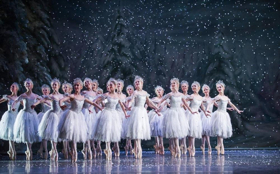Broadwayworld Dance Review: Birmingham Royal Ballet's The Nutcracker, December 29, 2018.

Let me start with off with a quote from the dean of American dance critics, Edwin Denby, written in 1944.
"...thousands of people all over the world find 'The Nutcracker' touching and comforting without knowing why. My point is simply that if you look for a reason ... you can find a great deal of meaning in 'The Nutcracker' and excellent reasons for its peculiar effect."
Everyone goes to The Nutcracker looking for meaning, as there is quite a bit of it to be found, especially in the glorious Tchaikovsky music. Sometimes the emotional pulse can be hard to find when choreographers produce versions so over the top that I often wonder what they were thinking. Luckily, I haven't seen a space age Nutcracker. I'm sure that will come.
But what about something so unique, so overpowering, marrying the narrative with the music? Is it out there in choreography land?
That all depends on who you ask.
Balanchine has been the king of Nutcrackers since his version was introduced in 1954. Why not? It's beautiful, no questions asked. Now there is a superabundance of them. I can say that the The Nutcracker the Birmingham Royal Ballet presented at the Royal Albert Hall, one of the worst venues in which to present a dance performance, is definitely not one of the world's most shattering. But what the hell? It sells tickets, even if it's in competition with the Royal Ballet and English National Ballet nearby. And you know what talks and what walks.
One thing I find peculiar about this Nutcracker is the amount of people responsible for its choreography. It has choreography by Peter Wright, Lev Ivanov and Vincent Redmon, with additional choreography by David Bintley and Marion Tait, and the production staged by David Bintley. So who did what? To be honest, it's easy to pinpoint the Ivanov pas de deux; the rest-I'm not so sure. But I've been told that overall, it's by Bintley.
This version has its own conceit. We hear the voice of Drosselmeyer (in the rounded Germanic tones of Simon Callow-he sounds ridiculous), at times, commenting on the story, explaining what has transpired-as if we couldn't make it out. Well, he's right! On the other hand, the lighting was so dark and grim, it probably was a good idea for some narration.
(Lighting designers, take note. We need you, because if future productions will be enveloped in darkness, dance will totally disappear from the world. And no doubt some snippy critic will pen a critique and call it "Dancing in the Dark". Don't laugh.
So we are in some city, it's Christmas Eve, guests arrive, cadets arrive (is this Graduation Ball?), and then things get a bit thorny. Blame it on the lighting or the dramaturgy. I was totally mixed up if Drosselmeyer did give Clara the nutcracker, who was really a cadet, who became her prince, who materialized into the Sugar Plum's cavalier, even if the Christmas tree never grew. I know, you're confused, Then Clara sailed off in Act One to the land of the Sweets, where she participated in or watched the divertissements. Unlike some other psychological Nutcrackers, she didn't do the Sugar Plum variation or the pas de deux, even as you were bombarded by projections on either side of the stage, illuminating almost nothing except what you were seeing right there on stage.
But the London Philharmonic Orchestra, conducted by Koen Kessels, played beautifully on top of the stage, as there was no room to put them anywhere else.
Note: Please don't present a dance performance in a concert venue-I already wrote about this, but I've got to reiterate. The stage does not have depth. People need to keep their eyes on the dancers, not have them roaming hither and yon. OK?
Since most of us are accustomed to the Balanchine divertissements of The Nutcracker, I can't say that I warmed to the finger pointing of the Chinese dance; the hot and heavy Arabian dance; the smoldering Spanish Dance, the three Cossacks of the Russian dance , the flute playing (I think that's what it was) mirlitons, or the charmless flowers. If you're wondering about Mother Ginger, she was nowhere to be found.
Céline Gittens and Brandon Lawrence as the Sugar Plum Fairy and her Cavalier were entrusted with the Ivanov pas de deux, which has survived to his day in some form or another from the original 1892 Russian production. Even Balanchine incorporates it in his production. At once strictly formal and classical, playful, yet ultimately strongly affirming a sense of overarching love, the pas de deux tests classical ballet dancers to the limit, not only their technical skill but their mastery of music. If Gittens and Lawrence could not yet scale these heights, perhaps they might in the future.
I still say that had this been seen in a venue other than the Royal Albert Hall, I might have thought differently. Perhaps next year.
Comments
.png)
|
.png)
|
Videos


